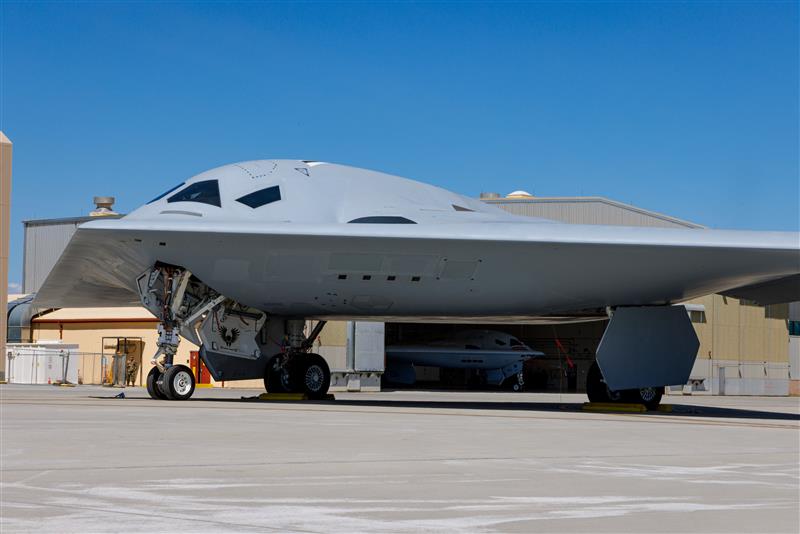The second B-21 Raider, which flew for the first time Sept. 11, will be used to test weapons and mission systems for the new bomber, contractor Northrop Grumman told Air & Space Forces Magazine.
The aircraft, which took off from Northrop’s Air Force Plant 42 facility in Palmdale, Calif., and landed at Edwards Air Force Base, Calif, lacked the leading-edge test boom and trailing cone seen on the first B-21, which has the nickname “Cerberus” and made its first flight Nov. 10, 2023.
Asked to explain the difference in configuration, a Northrop spokesman said Sept. 19 that tail No. 1’s primary role for the test fleet is to “validate flight sciences, handling qualities and envelope expansion. With this second test aircraft we move into a more advanced stage of testing: the weapons and mission systems that make the B-21 Raider a stealth bomber.”
The Air Force has said the B-21 will be able to carry the B61 nuclear bomb, the AGM-181 Long-Range Stand Off nuclear missile, and the next-generation penetrator; a successor to the AGM-57 Massive Ordnance Penetrator recently used to attack deeply buried Iranian nuclear weapon development facilities. The bomber is also likely to carry a large subset of other Air Force ground-attack munitions.
While the first B-21 sported the name “Cerberus” and an image of a three-headed dog on the outer nose gear door, the second carried a stylized winged Spartan helmet and crossed spears on its inner nose gear door, suggesting it also bears a Greek mythological nickname.
Both of the test aircraft are assigned to the 420th Test Squadron at Edwards.
In testing a new type of aircraft, the Air Force typically designates one for handling qualities, flutter, and envelope expansion. The others are then dedicated to testing things like:
- Engines
- Operational capabilities and sensors
- Extreme flight conditions
- Extreme climatic conditions
- Reliability and durability
- In more recent types, stealth
The Air Force has not said how many B-21s it intends to dedicate to testing, but the size of the first lot—five aircraft—aligns with typical test requirements, including non-flying ground test models.
The service has said that with only one or two exceptions, the B-21 test aircraft will be converted to operational versions fully capable of carrying out combat missions. Northrop officials say the test aircraft are being built on production tooling and in an almost completely operational configuration. That has been made possible by its digital design, which company officials said has been validated by real-world test results.
In a press release coinciding with the No. 2 aircraft’s first flight, Northrop said it has “an enhanced software package [which] will demonstrate how Northrop Grumman will deliver seamless upgrades to the B-21 fleet, ensuring its mission capability and weapons evolve to outpace any threat.”
The company also said the arrival of the second airframe in flight test “complements a robust ground test campaign that includes multiple B-21 aircraft. Engineers have rigorously tested the B-21 to certify it can fly in the most extreme mission conditions and are demonstrating the B-21’s durability by simulating lifetimes of flight conditions. These test results continue to consistently outperform digital modeling predictions, reinforcing confidence in the B-21’s performance and progress.”
The Air Force said the addition of a second flying B-21 will accelerate testing. The service has not said how long it expects the B-21 test campaign to take before declaring the type operational. The first base slated to receive operational B-21s is Ellsworth Air Force Base, S.D., which will then hand off its B-1Bs to Dyess Air Force Base, Texas.
Northrop said it’s developing “high-fidelity, full-motion simulators, immersive labs, and virtual spaces” to help the Air Force prepare to fly and sustain the B-21 at Ellsworth, including a “Fleet Management Tool” which it did not describe in detail, but is likely based on experience with the B-2, and which will help keep the jet “mission ready.”
The Northrop spokesman also said the firm is “scaling and ready to accelerate production, while partnering with the Air Force on the training and tools they need to field and operate this capability, maximizing the benefit B-21 brings to national defense with speed.”
This is a reference to Congress adding $4.5 billion to the B-21 production in the recent reconciliation bill. However, neither Congress nor the service have said how much additional, per-year capacity will be added to the production line, nor have they said how many B-21s Northrop is already prepared to produce. Air Force and industry officials have suggested that number is around seven per year.
Despite the funding for expanded production, the Air Force has also not specified a new objective fleet size for the B-21, continuing to say its goal is “at least 100” bomber. The head of Air Force Global Strike Command, Gen. Thomas A. Bussiere, and the head of U.S. Strategic Command, Gen. Anthony J. Cotton, have both said in recent months that a fleet of 145 B-21s would give the U.S. the capacity to meet the operational tempo required in a potential Indo-Pacific war. Some think tanks have suggested a figure closer to 200 is the true requirement, especially given that the Air Force plans to retire both the B-2 and B-1B in the early 2030s.


